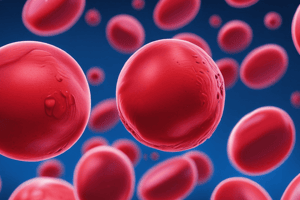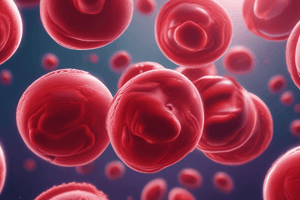Podcast
Questions and Answers
Where does the production of red blood cells (RBC) occur?
Where does the production of red blood cells (RBC) occur?
- Liver, lymph node, and spleen (correct)
- Kidneys and lungs
- Brain and stomach
- Heart and pancreas
Which cells differentiate into haemocytoblast (blood cell) during the production of RBC?
Which cells differentiate into haemocytoblast (blood cell) during the production of RBC?
- Early normoblast
- Proerythroblast
- Mature normoblast
- Primitive stem cells (correct)
What happens to the yellow marrow during the production of RBC?
What happens to the yellow marrow during the production of RBC?
- It remains unchanged during RBC production
- It becomes activated and loses fat, transforming into red marrow (correct)
- It becomes inactive and accumulates fat, transforming into white marrow
- It transforms into cartilage and bone tissue
Which cells give rise to the early normoblast during erythropoiesis?
Which cells give rise to the early normoblast during erythropoiesis?
What is the role of the haemocytoblast in the process of erythropoiesis?
What is the role of the haemocytoblast in the process of erythropoiesis?
What are the main sites for the production of RBC when the RBC production restarts?
What are the main sites for the production of RBC when the RBC production restarts?
Under what conditions does the yellow marrow become activated and produce RBC?
Under what conditions does the yellow marrow become activated and produce RBC?
What type of cells give rise to many other cells including red blood cells during erythropoiesis?
What type of cells give rise to many other cells including red blood cells during erythropoiesis?
Describe the characteristics of the early normoblast during erythropoiesis.
Describe the characteristics of the early normoblast during erythropoiesis.
What type of cells does the proerythroblast give rise to during the process of erythropoiesis?
What type of cells does the proerythroblast give rise to during the process of erythropoiesis?
Flashcards are hidden until you start studying
Study Notes
Erythropoiesis: Production of Red Blood Cells (RBCs)
- In certain conditions, RBC production increases in the liver, lymph nodes, and spleen.
- The yellow marrow in bones becomes activated, loses fat, and transforms into red marrow to produce RBCs.
- RBC production originates from primitive stem cells, which differentiate into haemocytoblasts (blood cells).
- Haemocytoblasts give rise to proerythroblasts and can also produce other cells, such as White Blood Cells (WBCs).
- Proerythroblasts develop into early normoblasts, which are large cells with many nucleoli and little cytoplasm.
- Early normoblasts (which only stain basic) mature into intermediate normoblasts (which stain acidic or basic dye).
- Stem cells in the bone marrow serve as building blocks for RBC production.
- The process of erythropoiesis involves the transformation of stem cells into RBCs through a series of developmental stages.
Studying That Suits You
Use AI to generate personalized quizzes and flashcards to suit your learning preferences.




